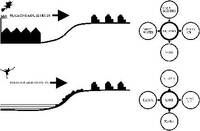- England
- Scotland
- France
- Holland
- Germany
- Italy
- Spain
- Portugal
- USA
- China
- Japan
- India
- Iran
- Advice
- Gardens
- England
- Scotland
- France
- Holland
- Germany
- Italy
- Spain
- Portugal
- USA
- China
- Japan
- India
- Iran
- Advice
- Garden Tours
Book: Landscape Planning and Environmental Impact Design: from EIA to EID
Chapter: Chapter 2 Landscape plans for public goods
Studies of economic relationships also take account of side effects. Alfred Marshall was the first to recognise their importance. He was particularly interested in the favourable impact of external economies on economic growth. When firms of a similar character are concentrated in a locality they develop interï¾dependencies. Each firm gains from the widening pool of skilled staff, specialist knowledge, new techniques and shared facilities. As in natural communities, the benefits become available to others as sideï¾effects of the firms' primary activities (Marshall 1961: 217). Since Marshall 's time economists have become more interested in the external diseconomies of industry: the unwanted side effects which impose a cost on surrounding land users (Samuelson 1973: 476,810). Smoky chimneys are the favourite example. Manufacturers produce smoke as a waste product and impose a cost on their neighbours, who must pay for higher laundry bills, more health care, extra window cleaning and repairs to buildings which have been damaged by air-borne acids [Fig 2.6]. Other famous examples of external diseconomies are soil erosion after forest clearance, effluent discharge, and the obstruction of beautiful views. Fig 2.7 The external effects of a land use can be sub-categorised as environmental impacts, landscape impacts and visual impacts When external effects influence the environment, they are known as environmental impacts [Fig 2.7]. A report on the environmental consequences of a development project is known as an Environmental Impact Statement [EIS]. The idea was introduced to America by the National Environmental Policy Act of 1969 and to Europe by the EC Directive 85/337 (Commission of the European Communities, 1985). A distinction can be made between two sub-categories of environmental impact. Landscape impacts 'are changes to the fabric, character and quality of the landscape as a result of development'. Visual impacts, a subset of landscape impacts, 'relate solely to changes in available views of the landscape' (Landscape Institute & Institute of Environmental Assessment, 1995). Fig 2.8 The environment has both a wicked stepmother (above) and a fairy godmother (below) Collectively, external diseconomies can be thought of as the environment's wicked stepmother [Fig 2.8]. Luckily she also has a fairy godmother: the external economies which first attracted Marshall 's notice. Street trees, parks and some building projects, like the Sydney Opera House, produce positive side-effects and confer public goods on the wider landscape. Inattention to positive side effects wastes resources and destroys landscape quality. Two types of measure can encourage fairy godmothers: - area-wide landscape plans, as discussed in this Chapter, for the environmental public goods. This requires an injection of ideals into the planning process. - single objective projects can be modified to improve their contextual relationships. In environmental assessment circles this is known as "impact mitigation". Development projects should be modified in order to produce multi-objective project designs. Design modifications can prevent negative environmental impacts and foster positive environmental impacts.
